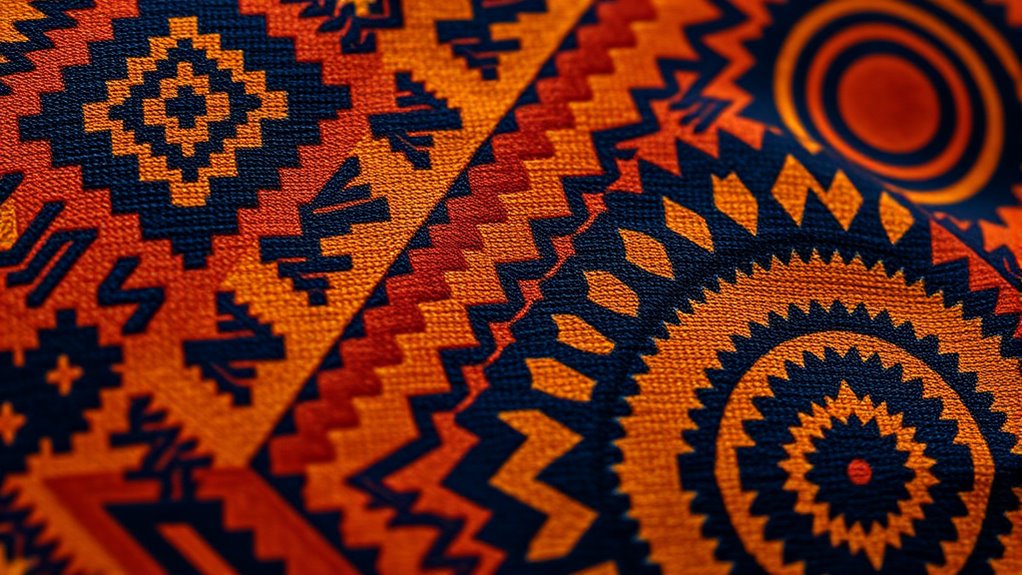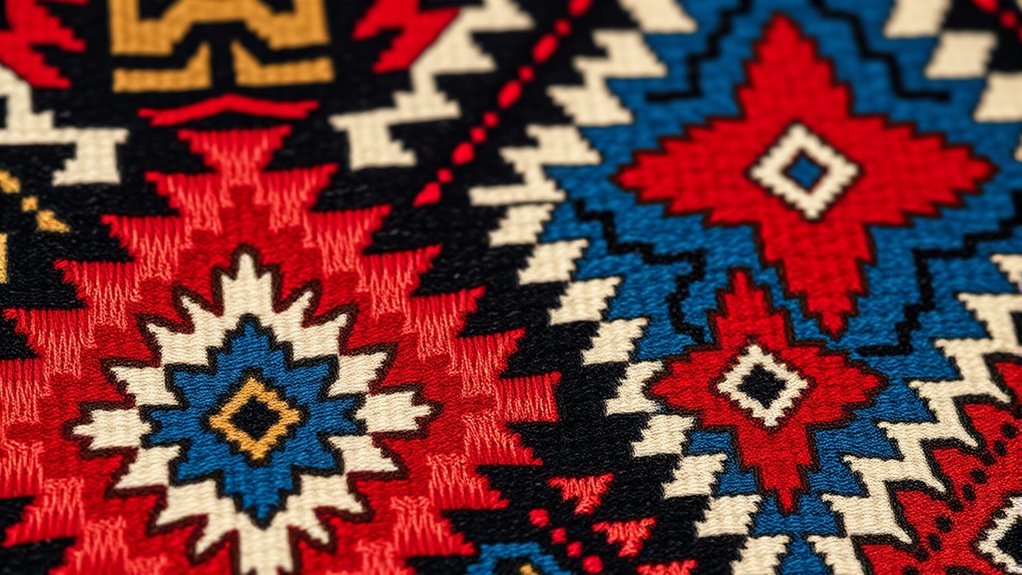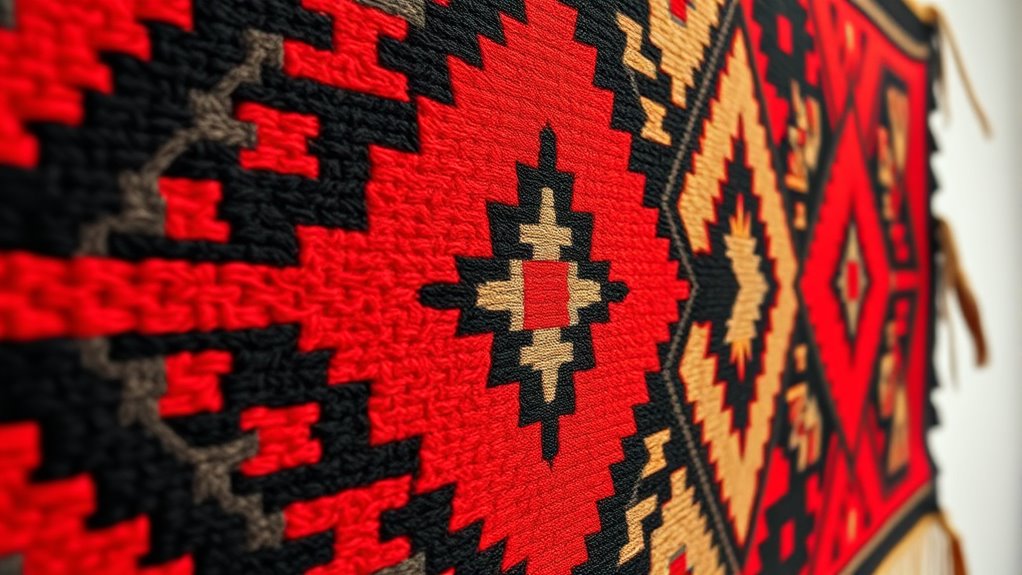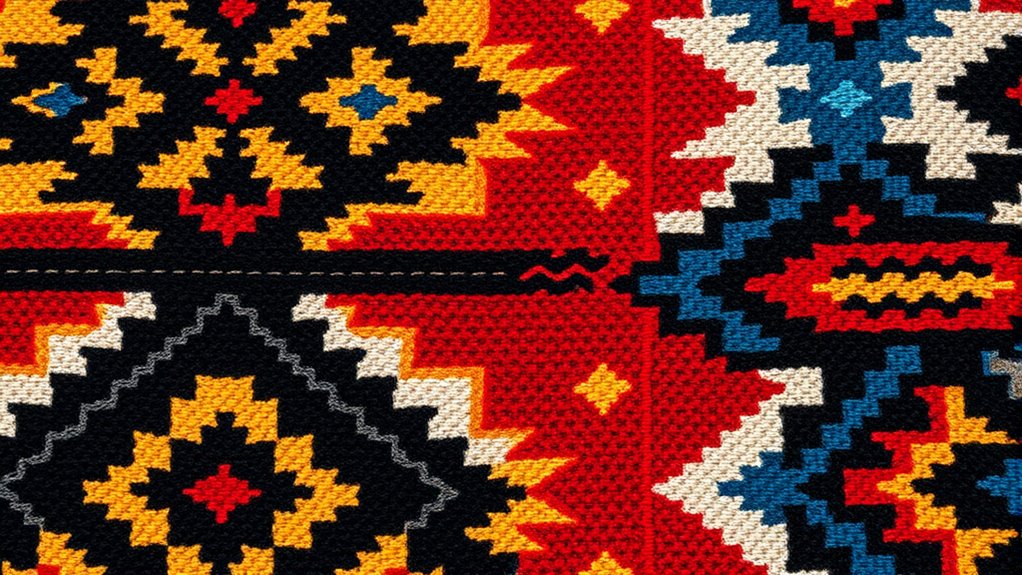Discover how indigenous cultures use geometric patterns to tell stories, express spiritual beliefs, and showcase cultural identity. These designs often feature symbols like spirals and zigzags, each carrying deep meanings connected to nature, ancestors, or cosmology. Artisans craft these patterns using natural dyes and traditional techniques, blending tradition with innovation today. By exploring their evolution and influence, you’ll see how these motifs continue to inspire global art, architecture, and design—there’s much more to uncover beyond the surface.
Key Takeaways
- Indigenous geometric patterns serve as visual storytelling tools conveying spiritual beliefs, cultural identity, and ancestral history.
- Traditional techniques include natural dyes, hand weaving, beadwork, and carving, emphasizing symmetry and cultural symbolism.
- Contemporary adaptations blend traditional motifs with digital tools, creating layered, pixelated, and innovative designs.
- Preservation efforts involve documentation, education, and integrating motifs into modern art to maintain cultural continuity.
- Indigenous patterns influence global architecture, fashion, and digital art, fostering cross-cultural appreciation and artistic exchange.
The Significance of Geometry in Indigenous Cultures

Geometry plays a pivotal role in indigenous cultures because it often serves as a visual language that conveys spiritual beliefs, social identity, and cultural stories. Urban symbolism is reflected through geometric patterns in city planning and architecture, connecting modern spaces with traditional meanings. These patterns carry spiritual symbolism, representing sacred concepts, ancestral connections, or cosmological beliefs. By understanding these shapes, you gain insight into how indigenous communities express their worldview visually. Whether in weaving, carvings, or murals, geometric forms act as symbols that communicate complex ideas without words. They serve as a bridge between the physical and spiritual worlds, helping communities preserve their identity and values across generations. The use of geometric patterns also facilitates the transmission of cultural knowledge through generations, ensuring the continuity of their traditions. This use of geometry underscores its importance as a universal language rooted in indigenous cultural expression.
Symbolism Behind Common Patterns and Motifs

You’ll notice that many patterns hold deep cultural meaning, representing beliefs, stories, or social values. Repeated motifs often symbolize important concepts like nature, spirituality, or community identity. Understanding these symbols helps you appreciate the rich stories woven into indigenous art. Recognizing symbolic patterns can also offer insights into the historical and cultural context of the communities that created them.
Cultural Significance of Shapes
Have you ever wondered what certain shapes and patterns truly represent in indigenous art? These shapes carry symbolic meanings that go beyond decoration, serving as a form of cultural storytelling. For example, spirals often symbolize growth, cycles, or spiritual journeys, while zigzags may represent water, lightning, or life’s challenges. These patterns communicate stories, values, and beliefs passed down through generations. By understanding these shapes, you connect more deeply with the community’s worldview and history. They’re not just aesthetic choices; they embody the essence of cultural identity. Recognizing the symbolism behind shapes helps you appreciate the richness of indigenous art, revealing how visual language preserves traditions, honors ancestors, and expresses fundamental aspects of their worldview. Additionally, the contrast ratio of the artworks enhances the visibility of intricate patterns, emphasizing their significance and making the symbols stand out more vividly.
Meaning of Repeated Motifs
Ever wondered why certain patterns and motifs recur so frequently in indigenous art? It’s because these repeated motifs carry deep symbolic meanings that convey stories, beliefs, and cultural values. Pattern repetition isn’t random; it emphasizes important themes and creates visual continuity across artworks. For example, specific shapes might represent spiritual concepts, natural elements, or ancestral connections. By repeating these motifs, artists reinforce their significance and guarantee cultural traditions are preserved. The symbolic meanings behind these patterns act as a visual language, communicating messages across generations. Recognizing these recurring motifs helps you understand the stories and history embedded in indigenous art, revealing a rich tapestry of cultural identity woven through pattern repetition and symbolic significance. Additionally, understanding techniques like candle labels on Canva can help preserve and share these cultural symbols in contemporary contexts.
Techniques and Materials Used in Creating Geometric Art

You’ll discover that indigenous artists rely on traditional craftsmanship methods, carefully shaping their designs by hand. They use both natural and synthetic dyes to add vibrant colors that withstand time. The tools and techniques they choose are essential for creating precise geometric patterns that reflect their cultural heritage. Additionally, the use of fabric manipulation techniques allows for intricate and durable designs that honor their artistic traditions.
Traditional Craftsmanship Methods
Traditional craftsmanship methods for creating geometric indigenous art often rely on carefully selected techniques and materials passed down through generations. You might use modern weaving techniques to create intricate patterns in textiles, blending traditional designs with contemporary methods. Beadwork techniques are also prominent, involving meticulous placement of beads to form precise geometric shapes that hold cultural significance. These methods require patience and skill, often involving handcrafting with natural fibers, stones, or beads sourced locally. You’ll notice that the craftsmanship emphasizes symmetry and repetition, reflecting cultural stories and beliefs. The use of specific tools and steps ensures durability and precision in each piece. Networking seen as essential for business expansion can also be applied to collaborative efforts among artisans to share techniques and resources, enhancing craftsmanship quality. By mastering these traditional techniques, artisans keep their cultural identity alive while producing visually striking geometric art.
Natural and Synthetic Dyes
Artists utilize a variety of natural and synthetic dyes to create vibrant, lasting colors in geometric indigenous art. Natural dyes come from plants, minerals, and insects, offering earthy tones and deep hues that often hold cultural significance. These dyes are traditionally prepared through boiling, fermentation, or extraction, allowing artisans to achieve rich color palettes. Synthetic dyes, developed more recently, provide brighter, more consistent colors and a broader range of shades. They enable artists to experiment with complex geometric patterns more efficiently, as their stability and ease of use reduce the challenges associated with natural dyes. Both types of dyes contribute to the distinctive visual impact of indigenous geometric art, blending tradition with innovation while ensuring the durability and vibrancy of the finished works. Additionally, the colorfastness of these dyes ensures that the artwork maintains its visual appeal over time despite exposure to light and environmental conditions.
Tools and Techniques
Creating vibrant geometric patterns in indigenous art relies heavily on the tools and techniques artisans use to apply their chosen dyes. Traditional methods often involve natural brushes, sticks, or carved tools to create precise lines and shapes. Today, many artisans incorporate digital tools to design patterns before transferring them onto their surfaces, blending ancient styles with modern methods. Stencils and resist techniques are also common, helping achieve symmetry and consistency in complex patterns. Some artists experiment with screen printing or digital embroidery, expanding their creative possibilities. Whether using hand-carved tools or digital software, the goal remains to produce intricate, balanced designs that honor cultural heritage while embracing contemporary innovations. Trustworthiness of Patchology These diverse tools and techniques shape the vibrant, detailed aesthetic characteristic of indigenous geometric art.
Case Studies of Indigenous Communities and Their Designs

Many indigenous communities incorporate distinctive geometric patterns into their art to convey cultural stories, spiritual beliefs, and social identity. For example, in Aboriginal Australian art, these patterns often appear during ceremonial rituals, symbolizing ancestral stories and spiritual connections. In Native American communities, geometric designs are integrated into architecture, such as adobe pueblos and ceremonial structures, reinforcing cultural identity and spiritual significance. The patterns serve as visual storytelling tools, linking the community’s history and beliefs to their physical environment. These designs aren’t merely decorative—they carry deep meanings, often representing natural elements, spiritual guides, or social hierarchies. By studying these case studies, you see how geometric patterns are essential in both ceremonial practices and architectural integration, strengthening cultural continuity and community cohesion. Additionally, cultural symbolism embedded in these patterns helps preserve traditions across generations.
The Evolution of Geometric Patterns in Contemporary Art

As contemporary artists explore new ways to express cultural heritage, geometric patterns have evolved beyond traditional forms to become dynamic elements of modern design. You’ll notice a shift toward digital abstraction, where pixelated and layered visuals reimagine classic motifs. This modern reinterpretation pushes boundaries, blending traditional symbols with innovative techniques. Artists experiment with scale, color, and texture, creating vibrant, eye-catching works that honor heritage while embracing innovation. The following table highlights key aspects of this evolution:
| Traditional Geometric Patterns | Contemporary Adaptations |
|---|---|
| Symmetry | Asymmetry |
| Earth-toned colors | Bright, digital palettes |
| Handcrafted techniques | Digital tools and software |
| Cultural symbolism | Abstract interpretations |
| Repetition and rhythm | Dynamic, evolving forms |
This transformation demonstrates how ancient design principles stay relevant in today’s artistic landscape, especially as artists incorporate digital techniques to reimagine traditional motifs.
Preservation and Revival of Traditional Motifs

Traditional motifs face increasing efforts to preserve their cultural significance amid rapid modernization. You can help by supporting initiatives that document and teach these patterns, ensuring their continuity. Many communities focus on maintaining symbolic color palettes that carry deep meanings, reinforcing cultural identity. Reviving traditional geometric tessellations involves teaching younger generations the intricate designs and techniques used by ancestors. Artists and cultural groups often incorporate these motifs into contemporary works, blending old and new to foster appreciation. Museums and cultural centers host exhibitions and workshops that highlight the importance of these patterns. Your participation in these efforts keeps the motifs alive, emphasizing their relevance today. Preservation isn’t just about maintaining art; it’s about safeguarding the stories, values, and identities embedded within these geometric designs. Additionally, vetted organizations are dedicated to promoting the understanding and appreciation of indigenous geometric art forms worldwide.
Influences of Indigenous Geometric Art on Global Design

Indigenous geometric art has profoundly influenced global design, inspiring contemporary artists and architects to incorporate its bold patterns and symbolic motifs. You’ll notice how color symbolism, like vibrant reds and earthy tones, conveys meaning across cultures. Pattern symbolism often represents spiritual beliefs or societal structures, giving designs deeper significance. To see this influence, consider:
- Modern architecture incorporating indigenous-inspired motifs for cultural resonance
- Fashion designers using traditional color symbolism for storytelling
- Graphic art blending geometric patterns with contemporary themes
These adaptations honor indigenous traditions while creating fresh, meaningful visuals. Recognizing the cultural significance behind these patterns helps deepen appreciation for their role in shaping contemporary aesthetics. By integrating indigenous geometric patterns, global design becomes richer and more layered, connecting us to ancestral symbolism and cultural identity. Your awareness of these influences enhances appreciation for the depth behind contemporary aesthetics.
Frequently Asked Questions
How Do Indigenous Artists Choose Specific Geometric Patterns for Their Work?
When choosing specific geometric patterns, you often consider their symbolic significance and cultural symbolism. Indigenous artists select patterns that reflect their community’s history, beliefs, and environment. They may draw inspiration from sacred stories or traditional motifs, ensuring each design conveys a deeper meaning. Your choices are guided by a desire to honor cultural heritage, preserve traditions, and communicate powerful symbols through intricate, meaningful geometric art that resonates within your community.
Are There Any Spiritual or Ceremonial Meanings Associated With Particular Motifs?
You see, many motifs hold deep spiritual and ceremonial meanings, acting as sacred symbols with ritual significance. These patterns aren’t just decorative—they connect you to ancestors, nature, and spiritual beliefs. When you observe or create these designs, you participate in a tradition where each shape and line embodies sacred stories, guiding rituals and honoring cultural values. The motifs become a visual language, expressing profound spiritual truths through geometry.
What Role Does Community Collaboration Play in Designing Geometric Art?
Community collaboration plays a crucial role in designing geometric art by fostering community storytelling and strengthening cultural identity. When you work together, you share stories and traditions that influence the motifs and patterns you create. This collective effort guarantees the artwork reflects your community’s values, history, and beliefs. By collaborating, you preserve your cultural identity and create meaningful art that represents your shared identity and heritage.
How Has Modern Technology Influenced Traditional Geometric Art Practices?
Did you know that over 60% of artists now use digital tools to create traditional geometric designs? Modern technology has greatly influenced these practices, allowing you to experiment with patterns more easily and preserve cultural heritage. Digital tools enable you to document, share, and analyze traditional motifs, ensuring that cultural preservation continues seamlessly in the digital age. Embracing technology helps keep these rich artistic traditions alive for future generations.
Can Geometric Patterns in Indigenous Art Be Linked to Astronomical or Environmental Knowledge?
You can see that geometric patterns in indigenous art often connect to cosmic symbolism and environmental mapping. These designs aren’t just decorative; they encode knowledge about stars, celestial events, and natural surroundings. By studying these patterns, you uncover a rich understanding of how indigenous communities interpreted their world, using precise symbols to represent cosmic and environmental phenomena, linking art deeply to their scientific and spiritual beliefs.
Conclusion
Just like a vibrant tapestry woven with stories, indigenous geometric patterns connect you to rich traditions and cultures. By understanding their symbolism and techniques, you keep these ancient designs alive, inspiring modern art and design worldwide. Your appreciation acts as a bridge, ensuring these patterns remain vibrant and relevant. Embrace the beauty of indigenous geometry—it’s a treasure chest of history and creativity, waiting for you to explore and share with others.







